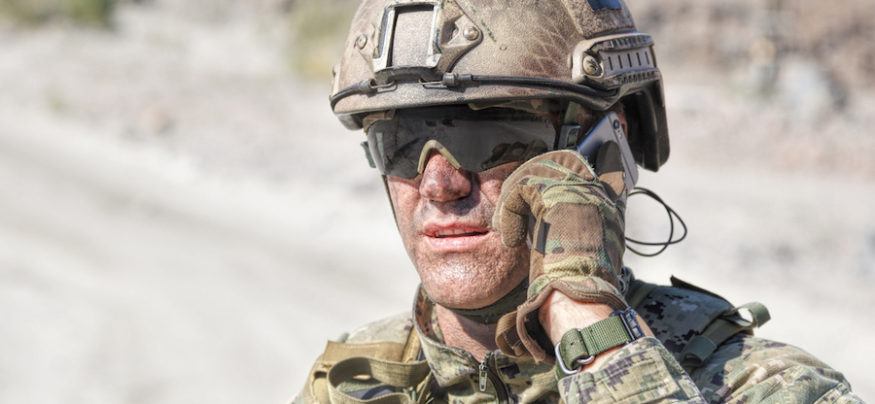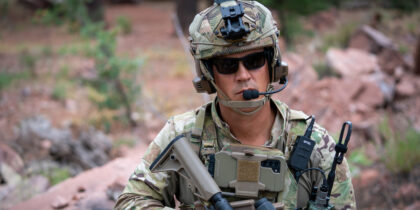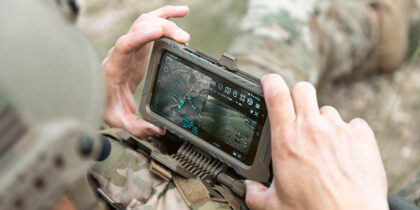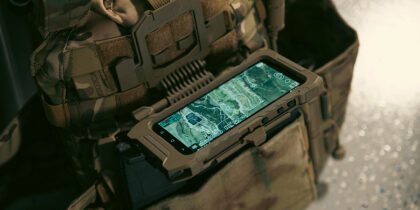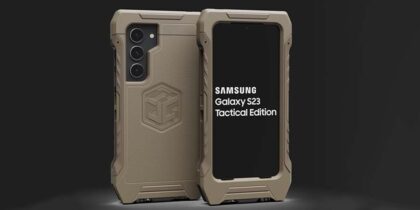“It’s about what the soldiers think,” said Maj. Ken Elgort, Product Manager Ground Soldier Systems, Nett Warrior, to a crowd of federal agencies, industry partners and distributors at last week’s Samsung Galaxy S9 Tactical Edition Industry Day held in the new Washington, D.C. Samsung Solutions Center. He was referring to the U.S. Army’s modernized technology acquisition approach and how emerging technologies ultimately make it into the hands of military personnel to support their missions.
According to Maj. Elgort, who participated in a fireside chat at the event, the Army is working diligently to explore new avenues to accelerate the deployment of new solutions that can help tactical operators gain battlefield advantage. Part of that process is adopting a DevOps approach where the Army collaborates closely with industry to discuss a concept, build a strategy and roll out small-scale trials to quickly see what works for users and doesn’t on the battlefield, according to FedScoop. To gain adoption, solutions must not just be technically sound, but also have the buy-in of soldiers, who can’t afford to be burdened by cumbersome or complex technology.
In fact, the NW system is one instance of how military leaders are embracing cutting-edge mobile technologies to augment tactical capabilities. The purpose of NW is to decrease combat loads, logistics footprints, communications vulnerabilities and strategic errors such as friendly fire. According to Maj. Elgort, the impact is very real: “The ability to do mission command on the move is greatly improved; that is the consensus.”
By working with industry to share detailed soldier and tactical command needs, use cases, and integration requirements, the Army is now able to develop, procure and deploy new mobile technologies “early and often,” according to Maj. Elgort. The benefits also extend to cost savings, allowing the Army to source devices at prices “substantially lower than what the Army would pay if it had to procure similar devices from contractors who would develop their own original devices,” according to an Army press release.
Collaboration Is Key
Industry and government collaboration was a theme that ran from Maj. Elgort’s session throughout the industry day. Much of the agenda focused on the hottest topic for attendees: the latest advancements around the Galaxy S9 Tactical Edition, a smartphone that features a preconfigured software suite, backed by Samsung Knox defense-grade security.
Transform Your Tactical Operations With Mobility
Discover how DoD is deploying mobile technologies to enhance and streamline tactical operations. Download Now
Designed as a single end-user device (EUD) that interoperates with tactical radios, communications systems and applications, Tactical Edition supports troops by powering use cases discussed over the course of the day such as:
- Enhanced situational awareness (SA) through geospatial applications such as ATAK and KILSWITCH
- Streamlined access to advanced communications, including geographic information system (GIS) mapping, site survey, radio controls, web browsing, chat and more for quicker C2 decision making
- Blue force tracking (BFT) capabilities to track enemy and friendly troop movement to reduce fratricide
- Improved battlefield coordination and agility for scenarios such as close air support (CAS)
The Galaxy S9 Tactical Edition Industry Day also explored additional mobile solutions that support tactical operations. For example, PAR Government’s Todd Krokowski, director of technology development, and Shawn Bisgrove, senior software engineer, provided insights on wearables use cases. They shared details on how wearables and hearables can be used to support SA by contextualizing information and alerting the user at the right time via “intelligent notification” haptic and audible cues during a firefight. By allowing soldiers to operate hands-free, they can focus on the mission without being distracted by looking down at their devices.
Not only can today’s wearable solutions send data to the user, but they can also transmit information about the user back to C2 and mission leaders so they can understand soldier health and performance. This could take the form of anything from a watch that monitors vitals to ballistics vests that can identify entry and exit wounds and alert for help when there’s a soldier down. One such example includes the battlefield assisted trauma distributed observation kit (BATDOK), a point-of-injury tool invented by researchers in the Air Force Research Laboratory to wirelessly monitor patients, according to TechLink.
Cybersecurity Solutions Must Underpin Tactical Solutions
The day also included deeper discussions on how the public and private mobile ecosystem can work together to balance innovation speed with cybersecurity challenges.
“Smart devices are not always used in the smartest way possible,” said presenter Gerald Pitpit, business area manager of secure network systems, mobile dynamic defense and battle space cybersecurity operations at Viasat, when explaining the need to protect mission critical data as agencies explore new mobile capabilities.
Security solutions such as Samsung Knox, which protects Samsung devices down to the hardware, enables federal agencies to maximize the power of mobility without the fear of compromising classified operations. By leveraging advanced security capabilities, like malware protection and behavioral analytics, to verify user identity, agencies can protect devices, systems and networks. This need is increasingly critical as high-profile cyberattacks dominate headlines and the Department of Defense (DoD) looks to double down on endpoint security.
Building a Forum for Continued Discussion and Innovation
According to the Modern War Institute, “Armies of the future that leverage smartphone innovations will change the face of war and reshape the modern battlefield into one that is befitting of the Information Age.”
What the Galaxy S9 Tactical Edition Industry Day demonstrated is that we’ve built a truly amazing ecosystem for delivering tailored mission-ready mobile solutions. From powering electronic flight bags (EFBs) to leveraging SA data for CAS, mobility is transforming tactical operations in more ways than we can imagine.
Already, many partners are sharing their solutions and vision, and Samsung looks forward to hosting additional conversations between industry and government throughout the year. This event was just the start of great things to come as industry and military collaborations push forward the boundaries of what mobile can do for DoD and all federal agencies.
Discover how Samsung’s government technology solutions can help agencies take their mission to the edge.
